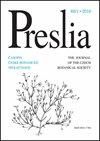Postglacial history and current population genetic diversity of a central-European forest plant Hacquetia epipactis
IF 2.9
2区 生物学
Q1 PLANT SCIENCES
引用次数: 10
Abstract
In the last decade, phylogeographical investigations have significantly contributed to our knowledge of the Quaternary history of several European species of trees in building forest ecosystems. In contrast, the phylogeography of midor low-altitude woodland understorey species that grow in moist and shaded forest habitats is still poorly understood. Here we focus on Hacquetia epipactis, a rare forest component of various types of deciduous forest communities, associated with Fagus sylvatica. We studied the genetic structure of populations of H. epipactis employing two molecular marker systems (AFLP fingerprinting and sequencing of several non-coding chloroplast DNA regions) to investigate the relationships among disjunctive groups of populations spanning its entire distribution in Europe (Dinaric Alps, Alps, Carpathians and adjacent Polish lowlands). The main goal of the present study was to explore the phylogeography and identify potential refugia and probable history of the development of the postglacial range of H. epipactis. We attempt to discuss this case study in the context of postglacial migration of forest forming species, especially beech, and postglacial assembly or co-migration of elements of forest communities. The non-coding chloroplast DNA showed a complete lack of genetic differentiation among populations, which may indicate a fast postglacial colonization from a single refugial area. AFLP data show no clear phylogeographical differentiation and indicate close relationships of the Dinaric and Carpathian/Moravian populations with a likely recent origin of the north-easternmost edge populations in Poland accompanied by a strong founder effect. Based on all the evidence, the most plausible scenario is a rapid, postglacial northward expansion from a Dinaric refugium, which concurs with the published postglacial scenario for beech. However, existence of a local refugium in the northern part of the present range is not excluded based on the distribution of genetic groups, which is also in congruence with the hypothetical last glacial history of beech. This suggests a possible shared migration history and role of Fagus expansion as the dominant species for the parallel establishment of Illyricoid species co-occurring in various beech-dominated communities. Limited gene flow among extant populations, due to disjunction and isolation at different spatial scales, is confirmed by significant correlation of genetic (pairwise Fst) and geographical distances.中欧森林植物黄夹竹桃冰期后历史及种群遗传多样性现状
在过去的十年中,系统地理学调查对我们了解欧洲几种树木在建立森林生态系统中的第四纪历史做出了重大贡献。相比之下,在潮湿和阴凉的森林生境中生长的中低海拔林地林下物种的系统地理学仍然知之甚少。本文重点研究了与森林Fagus sylvatica相关的阔叶林群落中罕见的森林成分haacquetia epipactis。本研究利用AFLP指纹图谱和非编码叶绿体DNA区域测序两种分子标记系统,研究了欧洲(阿尔卑斯山脉、阿尔卑斯山脉、喀尔巴阡山脉和邻近的波兰低地)不同居群间的遗传结构关系。本研究的主要目的是探索冰后冰期的种地理学,并确定潜在的避难所和可能的发展历史。我们试图在森林形成物种(尤其是山毛榉)的冰川后迁移和森林群落元素的冰川后组装或共迁移的背景下讨论这一案例研究。非编码叶绿体DNA显示种群之间完全缺乏遗传分化,这可能表明冰川后从单一避难区域快速定居。AFLP数据没有显示出明显的系统地理分化,并表明迪纳尔人和喀尔巴阡/摩拉维亚人的密切关系,可能是波兰最东北边缘人群的最近起源,伴随着强烈的奠基人效应。根据所有的证据,最合理的情况是,在冰川后,山毛榉从第纳尔避难所向北迅速扩张,这与已发表的冰川后山毛榉的情况一致。然而,根据遗传群的分布,不排除在目前范围的北部存在一个局部避难所,这也与假设的山毛榉末次冰期历史相一致。这表明在不同的山毛榉优势群落中,山毛榉作为优势种的扩张可能具有共同的迁移历史和作用。遗传距离(两两Fst)和地理距离的显著相关证实了现存种群之间由于不同空间尺度上的分离和隔离而产生的有限的基因流动。
本文章由计算机程序翻译,如有差异,请以英文原文为准。
求助全文
约1分钟内获得全文
求助全文
来源期刊

Preslia
生物-植物科学
CiteScore
5.20
自引率
29.40%
发文量
8
审稿时长
>12 weeks
期刊介绍:
Preslia is a peer-reviewed scientific journal publishing original research papers on plant systematics, morphology, phytogeography, ecology and vegetation science, with a geographical focus on central Europe. The journal was founded in 1914 and named in honour of brothers Jan Svatopluk Presl (1791–1849) and Karel Bořivoj Presl (1794–1852), outstanding Bohemian botanists. It is published quarterly by the Czech Botanical Society.
 求助内容:
求助内容: 应助结果提醒方式:
应助结果提醒方式:


